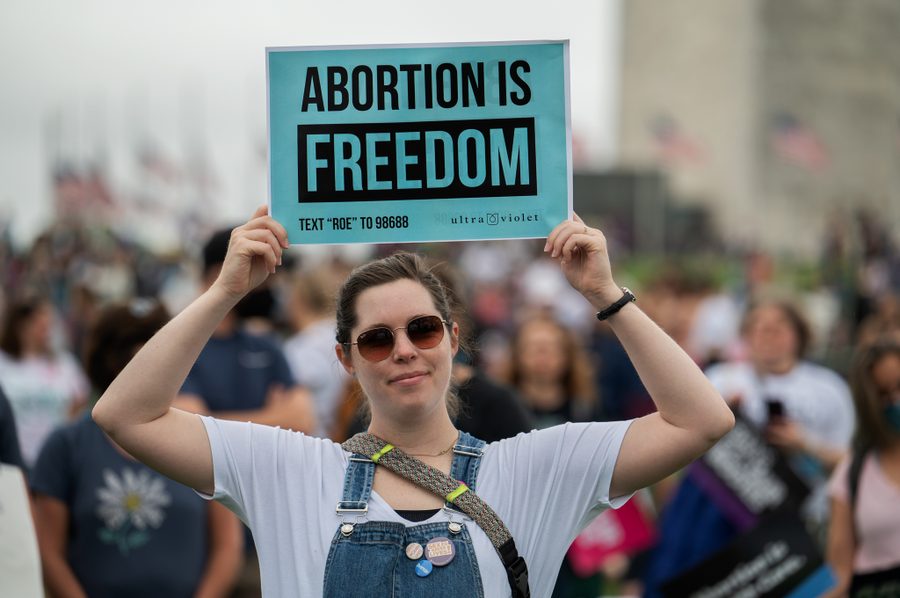Overturning Roe Will Be an Economic Catastrophe for Millions of Women
Abortion rights are economic rights.
Asha Banerjee

A leaked draft of a majority opinion authored by Supreme Court justice Samuel Alito strongly suggests that the court will rule to overturn Roe v. Wade and Planned Parenthood v. Casey, the two landmark cases that have upheld the right to an abortion nationwide for the last half century. If the final ruling largely follows what is sketched out in the leaked draft, abortion services will be drastically curtailed, if not outright banned, in over half the country.
Abortion is often framed as a “culture-war” issue, distinct from material “bread and butter” economic issues. In reality, abortion rights and economic progress are deeply interconnected, and the imminent loss of abortion rights means the loss of economic security, independence, and mobility for millions of women. The fall of Roe will be an additional economic blow, as women in the 26 states likely to ban abortion already face an economic landscape of lower wages, worker power, and access to health care.
Women’s economic lives, livelihoods, and mobility are at the heart of the reasoning to overrule Roe.
In the draft majority opinion, Justice Alito dismissed the argument in Casey that women had organized their lives, relationships, and careers with the availability of abortions services, writing “that form of reliance depends on an empirical question that is hard for anyone — and in particular, for a court — to assess, namely the effect of the abortion right on society and in particular on the lives of women.” In fact, this empirical question has been definitively assessed and answered. A rich and rigorous social science literature has examined both the detrimental effect of a denied abortion on women’s lives, as well as the individual and societal economic benefits of abortion legalization, as detailed in the thorough amicus brief filed in Dobbs on behalf of over 100 economists.
Some of the economic consequences of being denied an abortion include a higher chance of being in poverty even four years after; a lower likelihood of being employed full time; and an increase in unpaid debts and financial distress lasting years. Laws that restrict abortion providers, so-called “TRAP” laws (targeted regulation of abortion providers), have led to women in those states being less likely to move into higher-paying occupations.
On the flip side, environments in which abortion is legal and accessible have lower rates of teen first births and marriages. Abortion legalization has also been associated with reduced maternal mortality for Black women. The ability to delay having a child has been found to translate to significantly increased wages and labor earnings, especially among Black women, as well as increased likelihood of educational attainment. Treasury Secretary Janet Yellen concluded that “eliminating the rights of women to make decisions about when and whether to have children would have very damaging effects on the economy and would set women back decades.”
The draft opinion of this overtly partisan Supreme Court ignores the rigorous data and empirical studies demonstrating the significant economic consequences of this decision. In doing so, it lays bare the cruel and misogynistic politics that motivate it. Justice Alito’s dismissal of claims that forcing women to bear an unwanted pregnancy imposes a heavy burden is shockingly glib, as he simply asserts “that federal and state laws ban discrimination on the basis of pregnancy, that leave for pregnancy and childbirth are now guaranteed by law in many cases, that the costs of medical care associated with pregnancy are covered by insurance or government assistance….”
Every statement in this casual litany is wildly misleading. Women are still routinely fired for being pregnant, close to 9 in 10 workers lacked paid leave in 2020, the costs of maternity care with insurance have risen sharply and constitute a serious economic burden for even middle-income families. And many of the states certain or likely to ban abortion after the fall of Roe have not expanded Medicaid, leaving women without insurance facing much steeper costs — particularly in the immediate post-partum period. And, of course, our failed health care system often imposes the ultimate cost of all on pregnant women: The U.S. rate of maternal mortality, especially for Black women, ranks last among similarly wealthy countries. In short, the potential costs of bearing a child are high indeed, and it is women who should decide if and when they wish to shoulder them.
Recognizing that abortion is an economic issue is an important step in building support for protecting women’s right of access. But this recognition also allows us to see the potential fall of Roe v. Wade as a key piece in a broader politics and economics of control. Twenty-six states currently have laws or constitutional amendments on their books that ban abortion. If Roe is declared overruled, these bans will go into effect. Low- and middle-income women, especially Black and Brown women, will bear the brunt of the impact. Many of the states with preexisting abortion bans held at bay by Roe are also states that have created an economic policy architecture of low wages, barely functional or funded public services, at-will employment, and no paid leave or parental support. In these states, the denial of abortion services is one more piece in a sustained project of economic subjugation and disempowerment.
Figure A above shows the 26 states that have “trigger bans” that will set in immediately after the SCOTUS decision, pre-Roe bans or extreme limits, and likely bans. Figure A also shows the minimum wage in that state, whether that state is a so-called “right-to-work” state that makes it harder for workers to collectively bargain and unionize, whether the state has expanded Medicaid, and the rate of incarceration per 100,000 people in that state. While wages and access to health care (through Medicaid) are relatively obvious measures of well-being, so-called “right-to-work” laws are also useful to look at as worker power and unionization also have strong connections to economic, social, and physical health. Mass incarceration and the criminal justice system are also deeply intertwined with racial and economic inequality, from the impact of a criminal record on employment and earnings, to the intergenerational effects on families and communities.
It is no coincidence that the states that will ban abortion first are also largely the states with the lowest minimum wages, states less likely to have expanded Medicaid, states more likely to be anti-union “Right-to-Work” states, and states with higher-than-average incarceration rates. For example, among the states which will ban abortion, the average minimum wage is $8.39, compared with $11.48 in the states that have abortion access. Similarly, 10 of the 26 anti-abortion states have not expanded Medicaid, and all but two of the states are anti-union “right-to-work” states. While the nationwide rate of incarceration is 419 per 100,000 people, in the 26 anti-abortion states the average incarceration rate is 439 per 100,000 people, compared with 272 for the states without abortion restrictions. The consequences of low wages and lack of access to health care, including abortion services, falls especially hard on Black women in many of these states. There is a long history of racism motivating political organization, like the rise of “right-to-work” legislation in the Jim Crow south, or the complicated combination of anti-abortion politics and backlash against desegregation efforts during the political realignment of the 1970s.
Policymakers and advocates must recognize that the fall of Roe is an economic issue and would be one more victory for the economics of control and disempowerment — low wages, little worker power, and rising disinvestment. Reproductive justice is key to economic justice and protects women’s humanity, dignity, and the right to exert freedom over their own choices in the economy.
This story was first posted at Economic Policy Institute.
Asha Banerjee is an Economic Analyst at the Economic Policy Institute.


